This article analyses the factors behind the fall in the net income deficit. The decline in the net income deficit is a function both of a significant slowing in the rate of growth of Australia's net foreign liabilities and a reduction in the average yield on net foreign liabilities. As a result, Australia's capacity to finance its external liabilities is the strongest it has been for some time.
Summary
Australia's current account deficit (CAD) was 3.2 per cent of GDP in the December quarter 2000. This followed the recent peak of 6.1 per cent of GDP in the September quarter 1999, reflecting the effects of the Asian financial and economic crisis on the balance of trade. However, as a percentage of GDP, the September quarter 1999 outcome was below previous peaks recorded during the 1980s and early 1990s.
A key factor constraining the current account deficit to a lower peak during the Asian crisis, and contributing to the subsequent sharp decline, has been the decline in the net income deficit since the mid-1990s. In turn, this reflects:
- A change in the currency composition of net foreign liabilities, so that an across-the-board depreciation in the exchange rate now reduces net foreign liabilities and the net income deficit.
- Lower `world' interest rates, reflecting, amongst other things, lower global inflationary pressures.
- A reduction in the interest rate premium foreign investors require to invest in Australia.
The lower net income deficit has some significant implications:
- Australia's ability to finance its external obligations is now the strongest it has been in some time.
- The income earned by Australian residents (gross national income) has grown at a faster rate over the course of the 1990s than gross domestic product (the income produced in Australia).
Introduction
Australia's external current account has been in deficit for all but two years since the mid-1950s. However, there was a significant deterioration in the current account deficit in the early 1980s.1
From an average of 1 per cent of GDP in the 1970s, Australia's current account deficit increased sharply in the early 1980s, to average around 4 per cent of GDP in the 1980s as a whole. In turn, there was a significant increase in the net income deficit - the overall cost of financing net foreign liabilities.
The growth in net foreign liabilities, in particular net foreign debt, in the 1980s and early 1990s, and the associated increase in the net income and current account deficits were the source of considerable public policy debate.2 Some commentators were concerned that the increase in the current account deficit was leading to a rapid build up in net foreign liabilities, which in turn was leading to rapid increases in the cost of servicing these net foreign liabilities, and that these were reinforcing each other over time.
As it happened, over the course of the 1990s the current account deficit remained at an average of around 4 per cent of GDP, with cyclical peaks declining over the course of the decade. A key feature of the current account deficit since the mid-1990s has been the significant decline in the net income deficit as a share of GDP.
The net income deficit was 2.9 per cent of GDP in the December quarter 2000, up slightly from the September quarter 2000, but otherwise the lowest level since September 1993, and well below the level of around 4 per cent of GDP recorded in the mid-1990s (Chart 1).
This article analyses the factors behind the fall in the net income deficit.
Chart 1: Recent movements in the net income deficit
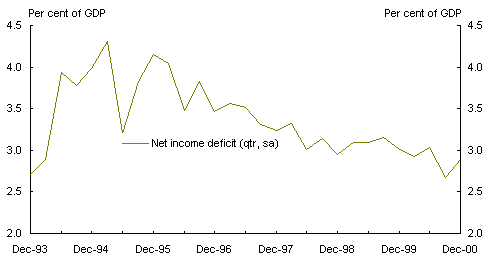
Source: ABS Cat No. 5302.0, 5206.0.
What drives the net income deficit?
The net income deficit is largely comprised of income payments and receipts on capital, as well as cross-border labour income (compensation of employees). Given the relatively small level of net cross-border labour income payments, there are two key drivers of the net income deficit: the level of net foreign liabilities being financed and the yield on those liabilities. Expressions for accounting identities and other equations are outlined in a Technical Appendix.
The net income deficit and net foreign liabilities have both increased as a percentage of GDP over the past two decades (Chart 2). This relationship is not one-for-one because of the variations in the yield on net foreign liabilities (Chart 3). These two drivers of the net income deficit: the level of, and the yield on, net foreign liabilities are examined in turn.
Chart 2: Relationship of the net income deficit and
net foreign liabilities
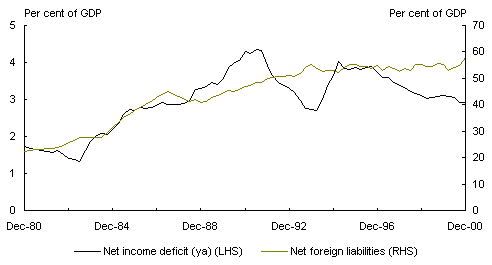
Source: ABS Cat No. 5302.0, 5206.0.
Chart 3: Relationship of net income deficit and
net foreign liabilities yield
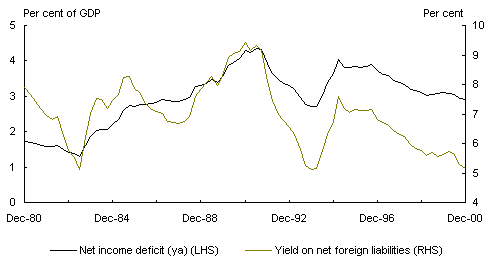
Source: ABS Cat No. 5302.0, 5206.0.
Net foreign liabilities
Changes in the Australian dollar level of net foreign liabilities broadly reflect: net `new' capital investment in the period; valuation effects associated with exchange rate movements and asset price changes; and other adjustments.
In the context of a growing economy, it can be misleading to use a simple Australian dollar measure when analysing the growth of net foreign liabilities over time. As a result, it is more useful to express net foreign liabilities as a share of gross domestic product (ie, income). However, care should be taken in the interpretation of the absolute level of such a measure.
The contribution of the different factors to the growth in net foreign liabilities as a share of GDP over the last two decades is provided in Table 1.
Table 1: Contributions to growth in net foreign liabilities as a
share of GDP
|
June 1980 |
June 1985 |
June 1990 |
June 1995 |
|
| NFL/GDP (start) |
21 |
35 |
45 |
54 |
| New transactions |
15 |
21 |
18 |
20 |
| Net income deficit |
7 |
13 |
16 |
16 |
| Balance of trade |
9 |
8 |
3 |
6 |
| Other3 |
-1 |
0 |
-1 |
-2 |
| Valuation & other effects |
8 |
3 |
-1 |
-1 |
| Exchange rate |
n/a |
04 |
-1 |
1 |
| Price changes |
n/a |
0 |
1 |
-2 |
| Other adjustments |
n/a |
1 |
-1 |
-1 |
| GDP |
-9 |
-15 |
-8 |
-15 |
| NFL/GDP (end) |
35 |
45 |
54 |
58 |
Source: ABS Cat No. 5302.0, 5206.0.
Net foreign liabilities increased sharply from 21 per cent of GDP ($27 billion) in the June quarter 1980 to 35 per cent of GDP ($79 billion) in the June quarter 1985. While around two-thirds of the increase reflected transactions financing the current account deficit, the remaining one-third reflected the impact of exchange rate changes (depreciation), asset price changes and other adjustments.5
Net foreign liabilities continued to increase in the second half of the 1980s, albeit at a slower rate. Between June 1985 and June 1990, net foreign liabilities rose from 35 per cent of GDP ($79 billion) to 45 per cent of GDP ($173 billion). Transactions required to finance the current account deficit were responsible for the vast bulk of this increase (over 85 per cent).
In the first half of the 1990s, net foreign liabilities continued to increase, so that by the mid-1990s (June quarter 1995), net foreign liabilities had grown to 54 per cent of GDP ($256 billion). Since then, net foreign liabilities have been relatively stable as a share of GDP, increasing to 58 per cent of GDP ($379 billion). Over the 1990s transactions financing the current account deficit were responsible for all of the increase in net foreign liabilities as a share of GDP (Chart 4).6
Chart 4: Contribution to growth of net foreign liabilities
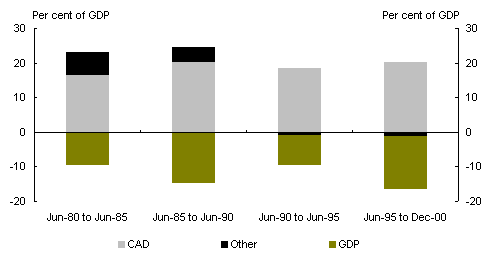
Source: ABS Cat No. 5302.0, 5206.0.
The following sections analyse in detail the factors behind variations in net foreign liabilities.
Net new capital transactions - `financing the current account'
It is clear that net new capital transactions have been a key determinant of the increase in net foreign liabilities over the past two decades. This can be thought of as `financing the current account deficit'.
As outlined in Table 1, the net income deficit has been the key determinant of the increase in net foreign liabilities over the past decade. This increase in net foreign liabilities has in turn fed back into subsequent movements in the net income deficit. The trade deficit contributed less to the growth in net foreign liabilities in the 1990s than in it did in the 1980s. Net current and capital transfers have acted to reduce net foreign liabilities moderately over the past two decades.
Impact of exchange rate movements
Variations in exchange rates can have a significant impact on the Australian dollar value of assets and liabilities denominated in a foreign currency. Where foreign investment in Australia is denominated in a foreign currency, the Australian dollar value of the foreign investors' assets will rise as the Australian dollar depreciates against that currency and vice versa. Similarly, where an Australian investment abroad is denominated in a foreign currency the Australian dollar value rises as the Australian dollar depreciates against that currency.
An indication of the sensitivity of net foreign liabilities to exchange rate variations can be obtained by estimating the proportion of net foreign liabilities denominated in foreign currency.
The methodology for estimating the proportion of net foreign liabilities denominated in foreign currency is outlined in the Technical Appendix.
Estimates of Australia's net foreign currency denominated asset position are presented in Chart 5. These estimates update those outlined in the Winter 2000 Economic Roundup7 for the effect of the ABS' revisions to historical data on Australian investment abroad, and incorporate a more detailed revised estimation methodology than previous estimates.
Chart 5: Net foreign currency denominated assets
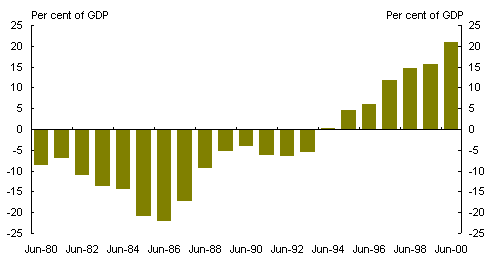
Source: ABS Cat No. 5302.0, 5363.0, 5206.0, 5305.0, 5306.0, Treasury estimates.
Australia has moved to a net positive position in relation to foreign currency denominated assets. As a result, an across-the-board depreciation in exchange rate results in a reduction in net foreign liabilities. This is a significant change to the situation in the mid-1980s, where significant currency depreciation resulted in higher net foreign liabilities and net income deficits.8
The weighting of currencies in which Australia's foreign currency assets and liabilities are denominated differs significantly from their trade weights. In particular, the United States dollar and Great British pound have a significantly greater weighting for investment than for trade, while the reverse is true for the Japanese Yen.
Nevertheless, over the past two decades, the exchange rate weighted by Australia's foreign currency denominated assets and liabilities has generally moved in line with the trade weighted index (Chart 6).
Chart 6: `Investment' and `trade' weighted exchange rates
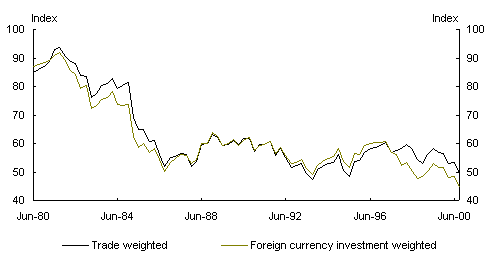
Source: Reserve Bank of Australia, Treasury estimates.
Impact of asset price changes
The level of net foreign liabilities can also be affecte
d by changes in asset prices. On the one hand, net foreign liabilities rise when the price of foreign investors' assets rises. The flipside is that when the price of Australian investors overseas assets rises, net foreign liabilities fall.
Data estimating the impact of asset price changes on the level of net foreign liabilities, Australian investment abroad and foreign investment in Australia are available from the September (quarter) 1988 to September 2000. Over the period from September 1988 to September 2000 the net effect of asset price changes has been a decrease in net foreign liabilities by around $10 billion, or more than 1 per cent of GDP.9
Although the net impact is relatively small, asset price changes have increased both Australian investment abroad and foreign investment in Australia significantly over the past decade. Australian investment abroad increased $108 billion or 16 per cent of GDP due to asset price changes between September 1988 and September 2000, while asset price changes increased foreign investment in Australia by around $98 billion or 15 per cent of GDP over the same period.
However, some care is needed in interpreting this outcome. In particular, it can be difficult to compare asset price movements between categories and over time. In examining these changes one could look at either the level or the rate of asset price changes in disaggregated asset classifications.
In level terms, from September 1988 to September 2000 asset price changes increased Australian direct equity investment abroad by significantly more than foreign direct equity investment in Australia ($67 billion compared to $24 billion - see Table 3). This difference is even more pronounced when expressed as an average rate of growth due to asset price changes. Under this measure, asset prices contributed more than 4 per cent per annum on average over the period to the growth of Australian direct equity investment abroad, and only 1.8 per cent per annum to the growth in foreign direct equity investment in Australia.
For portfolio equity investment the reverse is the case in level terms, with asset prices driving foreign portfolio equity investment $65 billion higher from September 1988 to September 2000, increasing Australian portfolio equity investment abroad by $30 billion. However, this largely reflects the higher level of foreign portfolio equity investment in Australia. When expressed as an average rate of growth, there was little between the two measures, with asset prices adding a little over 7 per cent per annum to the growth of both inward and outward portfolio equity investment.
However, that the higher average rate of asset price growth for portfolio equity compared to direct equity investment, at least in part, reflects measurement issues.10
Financial derivatives exhibited a very high return for both Australian and foreign investors, possibly reflecting their high-risk exposure relative to capital value. On the other hand, debt securities and other investments have low average capital gains, reflecting the nature of these securities. This outcome is not surprising, as although in the short run the value of debt securities can vary significantly, over the life of the instrument these fluctuations cancel themselves out.
Other adjustments
`Other adjustments' comprise all other variations in the level of net foreign liabilities, such as bad debts and classification changes.11 Separate data on this component - only available after 1988 - suggest that it has not had a significant impact on the level of net foreign liabilities. Indeed, based on the analysis above, it is likely that much of the increase in `valuation and other effects' prior to 1988 was attributable to exchange rate variations.
Net foreign liabilities - summary
Overall, the pace of growth of net foreign liabilities as a share of GDP has slowed over the course of the 1990s, with little net growth in the second half of the 1990s. This reflects the current account deficit stabilising as a share of GDP (in turn reflecting lower net income deficit outcomes), a reversal of the valuation impact of a depreciation in the exchange rate effect, and a higher rate of asset price appreciation on Australian investment abroad than on foreign investment in Australia.
Yield on net foreign liabilities
The second driver of the net income deficit is the average yield on net foreign liabilities. The average yield on net foreign liabilities is affected not only by the yield required by foreign investors in Australia, but also by the level of Australian investment abroad and the relative yield on that investment.
In summary, the yield on Australia's net foreign liabilities can be expressed as a function of:
- `World' interest rates.
- A `country premium' (or discount) reflecting relative inflationary expectations and relative sovereign risk.
- An investment premium (or discount) reflecting the relative risk of the investment opportunities in Australia.
To analyse these factors a broad conceptual framework is needed for what drives the expected return on investments.
The Capital Asset Pricing Model (CAPM) expresses the expected return on an investment in terms of a `risk-free' interest rate, the riskiness of an investment and the market risk premium.12 Although more commonly employed in the context of equity securities, this construction is equally applicable to both debt and equity securities.
In the context of international investment, the impact of expected nominal movements in the exchange rate on the value of an investment also need to be taken into account in the expected return. However, consistent with international standards, the effect of exchange rate variations on the capital value of investments is not classified as income in the balance of payments, and is therefore not included in the measured yield on investment.
That is, the expected yield on all Australian investment abroad will reflect the yield on `risk-free' debt in the countries (and currencies) invested in,13 in turn reflecting the `real' interest rate and inflationary expectations;14 and the riskiness of investments undertaken abroad and the market premium. Similarly, the expected yield on foreign investment in Australia will reflect the yield on Australian risk-free debt, the relative riskiness of investments undertaken in Australia and the market premium.
This yields an expression for the difference between the yield on Australian investment abroad and foreign investment in Australia. This expression can be disaggregated further by assuming that the yield on `risk-free' debt depends on both inflationary expectations and the real rate of interest.
`World' interest rates
As a net borrower of funds, changes in the level of `world' interest rates will have a significant influence on Australia's net income deficit.
For the purposes of this analysis, the `world' interest rate is assumed to be equal to the risk-free interest rate weighted by Australian investment abroad (both debt and equity).15
Consistent with the approach for exchange rate variations, the currency and time to maturity16 of Australian investment abroad is determined by reference to ABS data as far as possible, with similar patterns assumed to prevail in the preceding period. The official cash interest rate and the prevailing yields on 3 and 10 year Government bonds were assumed to be equivalent to `risk-free' interest rates (with equity investments assumed to have a maturity of at least 10 years).
The fall over time in the resultant `world' interest rate helps to explain part of the peaks in the net income deficit over 4&nbs
p;per cent of GDP in the early and mid-1990s, and the intervening and subsequent declines below 3 per cent of GDP (Chart 7). However over the course of the past year or so, the net income deficit decreased at a time when world interest rates rose. This suggests that fluctuations in world interest rates alone are not able to explain the significant decrease in the net income deficit over the recent years.
Chart 7: Relationship between the NID and `world' interest rates
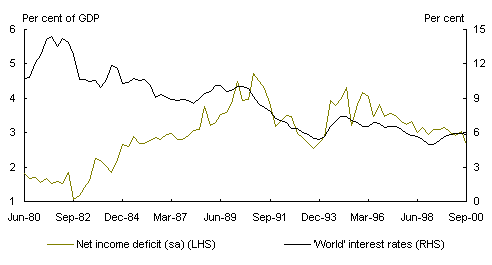
Source: RBA Bulletin, ABS Cat No. 5302.0, 5363, Datastream, Treasury estimates.
Premium on foreign investment in Australia
The past two decades have seen significant fluctuations in the premium on foreign investment in Australia (the extent to which the average yield17 on foreign investment in Australia has exceeded the average yield on Australian investment abroad)18. In the first half of the 1980s, the average premium was around of a per cent. The premium increased to around 1 per cent in the second half of the 1980s and 2 per cent in the first half of the 1990s, peaking at around 3 per cent in the early 1990s. Subsequently, the premium on foreign investment has declined to average around 1 per cent in the second half of the 1990s, and around of a per cent in the September quarter 2000 (Chart 8).
If sustained, this lower premium would mean that, for a given level of `world' interest rates, Australia's net income deficit on net foreign liabilities would be significantly lower than previously.
Chart 8: Premium paid on foreign investment in Australia
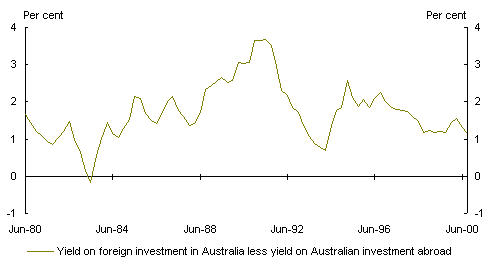
Source: ABS Cat No. 5302.0.
The question then is whether this premium reduction can be explained by a lower country and/or investment risk premium.
Country premium
As defined above, the `country premium' (or discount) on foreign investment in Australia is the difference between the `risk-free' interest rate weighted by the currency composition of foreign investment in Australia and the equivalent measure for Australian investment abroad (ie, the proxy for `world' interest rates outlined above).
The same methodology is used to construct a measure of the `risk-free' interest rate for foreign investment in Australia. The currency and time to maturity19 of foreign investment in Australia is determined by reference to ABS data as far as possible. The official cash interest rate and the prevailing yields on 3 and 10 year Government bonds were assumed to be equivalent to `risk-free' interest rates (with equity investments assumed to have a maturity of at least 10 years).
Chart 9: Comparison of 'risk-free' interest rates
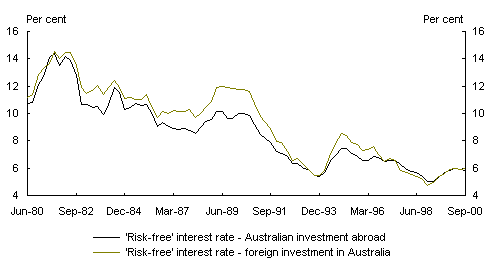
Source: ABS Cat No. 5302.0, 5305.0, 5306.0, 5363.0, Datastream, Treasury estimates.
The `country premium' is currently around zero, and has been around this level since December quarter 1996, down from a premium of around 100 basis points in the mid-1990s and around 200 basis points in the late 1980s and early 1990s (Chart 9). Further, over the past two decades the country premium has explained much of the variation in the average difference between the yield on foreign investment in Australia and Australian investment abroad (Chart 10). Importantly, the premium on foreign investment in Australia is currently in line with its longer-term relationship with the `country premium'.
Chart 10: Premium paid on FIA and 'country premium'
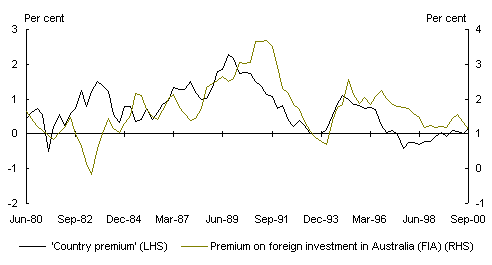
Source: ABS Cat No. 5302.0, 5305.0, 5306.0, 5363.0, Datastream, Treasury estimates.
As noted above, the `country premium' can be conceptually separated into inflationary expectations and sovereign (or `default') risk. That is, a reduction in the `country premium' may reflect a relative reduction in either or both of inflationary expectations or sovereign risk. However, it is difficult to separate the two measures with precision.20
The rating assigned to Australia's long term sovereign debt by leading ratings agencies can be a useful qualitative indicator of the degree of the `sovereign' risk premium. Douglas and Bartley (1997) noted the downgrading in the late 1980s of Australian Commonwealth Government debt by both Standard and Poor's and Moody's was not inconsistent with the argument that this may have been associated with a small country risk premia of around 0.25 per cent (in real terms) in the early 1990s.
More recently, Standard and Poor's upgraded their rating of Commonwealth Government debt in 1999, citing fiscal consolidation and a transparent medium term fiscal policy framework; the medium term framework for monetary policy and resultant low inflation environment in Australia; and continued structural reform in the labour and product markets, as factors supporting the upgrade. Indeed, Gruen and Stevens (2000) noted that by the end of the 1990s, `the real yield on $A-denominated bonds was roughly the same as those on German and US bonds'. This suggests that the default risk on Australian `risk-free' debt has declined over the course of the 1990s.
Investment risk premium
Changes in the investment risk premium, in particular, changes in investors' ex ante risk preferences, are difficult to observe in practice. In the current context, discussion is limited to analysis of the ex post yield on direct and portfolio equity securities.
Direct equity
Direct equity investments are those where the investor has an equity interest in 10 per cent or more of the ordinary capital or voting stock of the enterprise.21
In the first half of the 1980s, direct equity foreign investment in Australia yielded a lower return than Australian direct equity investment abroad. While returns were similar in the second half of the 1980s, in the early 1990s a wedge opened up between the returns, with foreign investment in Australia resulting in a higher yield than Australian investment abroad. Nevertheless, this premium has declined in recent years, from around 4 per cent in the mid-1990s to around 2 per cent in the September quarter 2000 (Chart 11).
Chart 11: Comparison of yields on direct equity investment
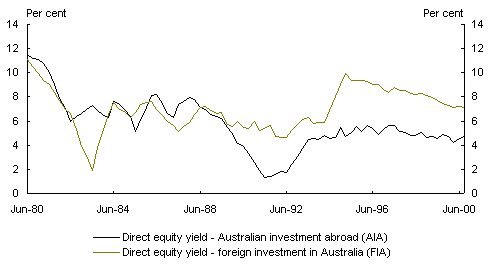
Source: ABS Cat No. 5302.0, Treasury estimates.
The changes in the premium on foreign direct equity investment over Australian equity investment abroad in the 1990s is partly, but not entirely, explained by changes in the `country' risk premium (Chart 12).
Chart 12: Comparison of direct equity premium and `country premium'
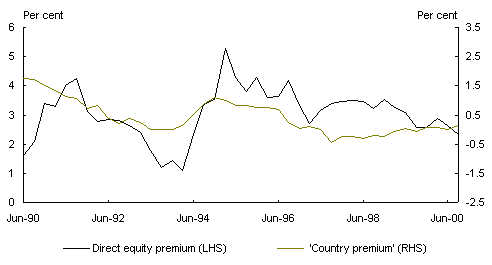
Source: ABS Cat No. 5302.0, 5306.0, 5363.0, Datastream, Treasury estimates.
The difference between these two premia is the ex post investment risk premium. On the face of it, it appears that the investment risk premium increased over the course of the 1990s, remaining relatively stable at 2 per cent in the second half of the 1990s. However, it should be remembered that the ex
pected return on direct equity investment includes the effect of expected asset price and exchange rate variations, which - consistent with international standards - are not included in income by the ABS. These factors can be added to items that are measured as income to derive a `total' ex post yield on direct equity investments. These results - while volatile - suggest that, on average over the 1990s, the total yield on Australian direct equity investment abroad exceeded that on foreign direct equity investment in Australia.
Portfolio equity
Portfolio equity investment is defined as equity investment other than direct investment or reserve assets. That is, equity investments are classified as portfolio in nature if they comprise less than 10 per cent of the issued equity capital of the entity.22
Portfolio foreign equity investment in Australia has consistently yielded more than Australian portfolio equity investment abroad (Chart 13). However, both yields are significantly below that on direct equity investment. This is likely to reflect the fact that the ABS - consistent with international standards - only record the dividend component as income. By comparison, retained earnings and undistributed branch profits are also included in income for direct equity investments. Thus, the higher yield of foreign portfolio equity investment in Australia suggests that the Australian companies pay a higher proportion of their earnings to shareholders as dividends.23
Chart 13: Comparison of yields on portfolio equity investment
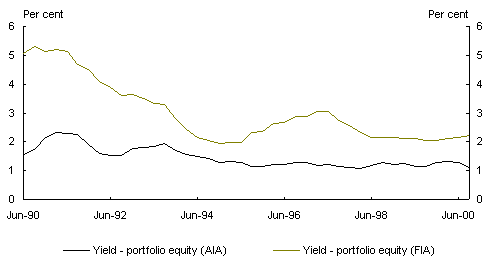
Source: ABS Cat No. 5302.0, Treasury estimates.
As with direct equity investments one way of adjusting for these factors is to include the effect of expected asset price and exchange rate variations to derive a total ex post yield on portfolio equity investments. On this basis, the average yield on portfolio equity investments has been about the same over the decade of the 1990s for Australian investment abroad and foreign investment in Australia.
Summary - yield on net foreign liabilities
It appears that a reduction in the premium between Australian interest rates and those in other developed countries since the mid-1990s has been an important factor in the recent decline in the net income deficit as a share of GDP.
Australia's net foreign liabilities stood at 58 per cent of GDP in the December quarter 2000. Therefore, a 1 percentage point reduction in the yield on net foreign liabilities - whether as a result of lower `world' investment yields or a reduction in the premium on investment in Australia - translates directly to around 0.6 per cent of GDP reduction in the net income deficit and, other things being equal, the current account deficit.
In addition, the impact of any premium on foreign investment in Australia increases with the level of Australian investment abroad.24 As Australian investment abroad was around 62 per cent of GDP in the September quarter 2000, a 1 percentage point reduction in the difference in the yield on foreign investment in Australia relative to Australian investment abroad translates to around 0.6 per cent of GDP reduction in the net income deficit and the current account deficit.
Conclusion
The decline of the net income deficit is both a function of a significant slowing in the rate of growth of Australia's net foreign liabilities and a reduction in the average yield on net foreign liabilities. In turn, this reflects changes in the currency composition of net foreign liabilities; lower `world' interest rates; and a reduction in the interest rate premium foreign investors require to invest in Australia.
As a result, Australia's capacity to finance its external liabilities is the strongest it has been for some time.
The debt servicing ratio - the level of exports required to pay the interest on net foreign debt - was 9.6 per cent in the December quarter 2000, less than half that recorded in the September quarter 1990. The net liabilities servicing ratio - the level of exports required to pay the cost of servicing foreign liabilities (both debt and equity) - was 13.1 per cent in the December quarter 2000, its lowest level since December 1983.
In addition, when the net income deficit declines as a share of GDP, it follows that Australia's gross national income (ie, the income earned by Australian residents) is increasing by more than GDP.
Over most of the 1980s, the net income deficit increased faster than GDP, indicated by the negative values of the line in Chart 14. Indeed, over the course of the 1980s the net income deficit increased from under 2 per cent of GDP in 1979-80 to around 4 per cent of GDP in 1989-90, an average increase of around 0.2 per cent of GDP per annum.
Chart 14: The net income deficit and gross national income
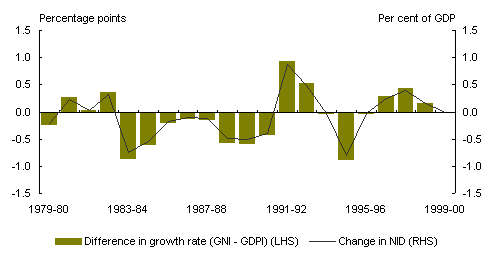
Source: ABS Cat No. 5302.0, 5206.0.
As a consequence, the income of Australian residents (ie, gross national income) was growing at a slower pace than total income produced in Australia (ie, gross domestic product), shown by the negative values of the bars in Chart 14.
This situation was reversed in the 1990s. Over most of that decade, the net income deficit grew at a slower pace than GDP (and even declined in absolute terms on four different occasions). Over the course of the 1990s the net income deficit decreased from around 4 per cent of GDP in 1989-90 to around 3 per cent of GDP in 1999-2000, an average decrease of around 0.1 per cent of GDP per annum. Consequently, income growth of Australian residents outpaced total income growth in Australia over most of the 1990s.
Bibliography
Australian Bureau of Statistics, 1998, Balance of Payments and International Investment Position: Sources, Concepts and Methods, Cat. No. 5331.0.
Australian Mining Industry Council, 1987, Paying the Banker: Facing Australia's Foreign Debt Problem, ed. R. Fraser.
Business Council of Australia, 1990, Australia's Foreign Debt: Challenges & Choices, Longman Professional.
Committee for the Economic Development of Australia, 1990, `Australia's Foreign Debt', Growth 38, ed. J. Nevile.
Commonwealth of Australia, 2000, Budget Strategy and Outlook 2000-01, Budget Paper No. 1, page 1-26.
![]() , 1996, Budget Statements 1996-97, Budget Paper No. 1.
, 1996, Budget Statements 1996-97, Budget Paper No. 1.
Douglas, J., and Bartley, S., 1997, `Risk Premia in Australian Interest Rates', The Australian Journal of Agricultural and Resource Economics, June 1997, pp 227-262.
Economic Planning Advisory Council, 1991, The Surge in Australia's Private Debt: Causes, Consequences, Outlook, Background Paper No. 14, AGPS.
Fisher, 1930, The Theory of Interest: As Determined by Impatience to Spend Income and Opportunity to Invest it., New York., Kelley & Millman, 1954.
Gittins, 1998, `Valuation Effect Won't Stand Examination', The Sydney Morning Herald, p.58.
Gruen, D., and Stevens, G., 2000, `Australian Macroeconomic Performance and Policies in the 1990s' in RBA, 2000, The Australian Economy in the 1990s.
McKibbin, W.J., 1998, `Risk re-Evaluation, Capital Flows and the Crisis in Asia' in Garnaut, R. and R. McLeod (eds) East Asia in Crisis: From Being a Miracle to Needing One?, pp 227-244, Routledge.
McKibbin, W.J., 1999, `International Capital Flows, Financial Reform & Consequences of Changing Risk Perceptions in APEC Economies', in Experiences
of Economic Reform within APEC, Institute of Policy Studies conference in Wellington, New Zealand, July 12-14 1999.
Makin, A., 1990, `The CAD: Not Really the Villain in Australia's Macroeconomic Melodrama', Economic Papers, 9(3): 77-84.
Pitchford, J.D., 1990, Australia's Foreign Debt: Myths and Realities, Allen & Unwin.
Reserve Bank of Australia, 1999, `Trade Weighted Index', Bulletin, October, p.16.
W.F. Sharpe, 1964, `Capital Asset Prices: A Theory of Market Equilibrium Under Conditions of Risk,' Journal of Finance 19: pp 425-442.
Treasury, 1996, Documentation of the Treasury Macroeconomic (TRYM) Model of the Australian Economy.
Treasury, 2000, `Economic Overview', Economic Roundup, Winter.
Technical appendix
This appendix contains the equations referred to in the main text of the article.
Equation 1
There are two key drivers of the net income deficit: the level of net foreign liabilities being financed and the rate of return on those liabilities.
![]() (1)
(1)
where:
NIDt = Net Income Deficit in period t
YieldNFL = Yield on net foreign liabilities
NFL(t-1) = Net Foreign Liabilities at the end of the previous period.
Equation 2
Changes in the level (in nominal terms) of net foreign liabilities reflect: net `new' capital transactions in the period; valuation effects associated with exchange rate movements and asset price changes; and other adjustments.
![]() or (2)
or (2)
![]()
where:
NNKTt = Net `new' capital transactions in the period t.
_APt = Change in the price of assets and liabilities comprising net foreign liabilities in the period t.
_XRt = Change in the exchange rate(s) in which net foreign liabilities are denominated in the period t.
Othert = Other adjustments in the period t.25
Equation 3
Equation 2 can be restructured to obtain an expression for the contribution of different factors to the change in net foreign liabilities as a share of GDP.
 (3)
(3)
Equation 4
Where an Australian investment abroad is denominated in a foreign currency the Australian dollar value rises as the Australian dollar depreciates against that currency.
![]() (4)
(4)
where:
FIA(FC) Foreign investment in Australia denominated in foreign currency.
AIA(FC) Australian investment abroad denominated in foreign currency.
Equation 5
An indication of the sensitivity of net foreign liabilities to exchange rate variations can be obtained by estimating the proportion of net foreign liabilities denominated in foreign currency.
![]() (5)
(5)
where:
FCNFL Foreign currency denominated net foreign liabilities
FIA(FCDebt) Foreign investment in foreign currency denominated debt
AIA(FCDebt) Australian investment in foreign currency denominated debt, including foreign currency denominated official reserve assets
AIA(Equ) Australian equity investments abroad
Investments in equity assets are assumed to be denominated in the currency where the investment is made. That is, foreign equity investments in Australia are assumed to be denominated in Australian dollars. Similarly, Australian equity investments abroad are assumed to be denominated in foreign currency.
Each quarter the ABS publishes data on the currency denomination of foreign debt assets and liabilities.26 Prior to September 1996, these data were only provided for foreign debt liabilities.27 Further, some foreign debt data has been revised subsequent to the most recent publication of currency disaggregation. However, an estimate for the level of foreign currency denominated debt liabilities is obtained by applying the most recent disaggregated currency data to the most recent data on foreign debt assets and liabilities.
The ABS and the Reserve Bank of Australia publish data on the foreign currency denominated component of official reserve assets.28 Around two-thirds of other foreign debt assets are assumed to have been denominated in foreign currency.29
Equation 6
The level of net foreign liabilities can also be affected by changes in asset prices. On the one hand, net foreign liabilities rise when the price of foreign investors' assets rises. The flipside is that when the price of Australian investors overseas assets rises, net foreign liabilities falls.
![]() (6)
(6)
where:
FIAt-1 = Foreign investment in Australia at the end of the previous period.
AIAt-1 = Australian investment abroad at the end of the previous period.
Equation 7
The average yield on net foreign liabilities is affected not only by the yield required by foreign investors in Australia, but also by the level of Australian investment abroad and the relative yield on that investment.
Equation 1 can be re-expressed as:
![]()
which can be expressed as:
![]() or: (7)
or: (7)
![]()
Equation 8
The Capital Asset Pricing Model (CAPM) expresses the expected return on an investment could in terms of a `risk-free' interest rate, the riskiness of an investment and the market risk premium.30
![]() (8)
(8)
where:
Rinvestment Expected return on investment
Rrisk-free `Risk-free' rate of return
Binvestment The riskiness' of the investment relative to the market (where 1 is the `market', and 0 is `risk-free')
Rmarket Average expected return on all investments in the relevant market
Equation 9
The interest rate reflects a real interest rate (in turn reflecting the demand and supply of capital) and the expected rate of inflation.31
![]() (9)
(9)
where:
rn Nominal rate of interest
rr Real rate of interest
ri Expected rate of inflation
Equation 10
The expected yield on all Australian investment abroad will reflect the yield on `risk-free' debt in the countries (and currencies) invested in, in turn reflecting the `real' interest rate and inflationary expectations; and the riskiness of investments undertaken and the market premium, as well as expected exchange rate variations.
![]() (10)
(10)
where:
Yiel
dAIAt = Expected yield on Australian investment abroad.
Rr-f(AIA) = Weighted `risk-free' rate of interest in the countries and currencies that comprise Australian investment abroad.
Rr-f(`world') = Weighted `risk-free' rate of interest all countries and currencies that comprise world investment.
Rm(`world') = Expected rate of return on the weighted average of world investments.
B(AIA) = Relative riskiness of Australian investments abroad compared with the weighted average of world investments.
__ _ Expected changes in the exchange rate.
Equation 11
The expected yield on foreign investment in Australia will reflect the yield on Australian risk-free debt, the relative riskiness of investments undertaken in Australia and expected exchange rate variations.
![]() (11)
(11)
where:
YieldFIAt = Expected yield on foreign investment in Australia.
Rr-f(FIA) = Weighted `risk-free' rate of interest in the currency composition of foreign investment in Australia.
Rmarket(world) = Expected rate of return on the weighted average of world investments.
_(AIA) = Relative riskiness of foreign investment in Australian compared with the weighted average of world investments.
_____ _ Expected changes in the exchange rate.
Equation 12
Subtracting equation 10 from equation 11 yields an expression for the difference between the yield on Australian investment abroad and foreign investment in Australia.
 (12)
(12)
Equation 13
Equation 12 can be disaggregated further by assuming that the yield on 'risk-free' debt depends on both Australian inflationary expectations and the real rate of interest.
 (13)
(13)
1 See Budget Strategy and Outlook 2000-01, Budget Paper No. 1, p 1-25 and Budget Statements 1996-97, Budget Paper No. 1, pp 2-30 to 2-39.
2 For example, AMIC (1987), BCA (1990), CEDA (1990), Pitchford (1990) Makin (1990) and EPAC (1991).
3 Current and capital transfers, net errors and omissions, net capital gains on the sale of non-financial assets.
4 Disaggregated data for exchange rate, asset price and other adjustments is from September 1988 to June 1990.
5 Disaggregated data on the `valuation & other effects' category is only available from the 1988-89 financial year.
6 Note that GDP growth reduces this ratio and shows up as a negative contribution in Chart 4.
7 Treasury (2000). Of course, this does not alter the fact that Australia remains in a net liability position overall.
8 See also, for example, Gittins, 1998, `Valuation Effect Won't Stand Examination', The Sydney Morning Herald, p.58.
9 This is the sum of the contribution to the growth in net foreign liabilities as a share of GDP each quarter. With the inclusion of the December quarter 2000, this small net decrease changes to a small net increase of around $6 billion or 1.0 per cent of GDP.
10 There are differences in what is defined as an asset price fluctuation between the different investment classifications. For example, for direct equity, retained earnings are included in the current income account, with the resulting change in the price of the asset being classified as a `new transaction' rather than an asset price change. On the other hand, for portfolio equity investments, only dividends are included as income on the current account, so any retained earnings are classified as an asset price change. As a result, it is not surprising that portfolio equity investments have a higher average asset price growth. For more information, see ABS (1998) Balance of Payments and International Investment Position: Sources, Concepts and Methods.
12 W.F. Sharpe, 1964, `Capital Asset Prices: A Theory of Market Equilibrium Under Conditions of Risk,' Journal of Finance 19: pp 425-442.
13 McKibbin (1999) noted that `within each economy all financial assets (bonds, money, equity etc) are being arbitraged and therefore removing [a] wedge between bond rates across countries will also affect the relative returns of a range of domestic and foreign assets'. See also McKibbin (1998).
14 Fisher, I., 1930, The Theory of Interest: As Determined by Impatience to Spend Income and Opportunity to Invest it., N.Y., Kelley & Millman, 1954 Xxxii, 566 P.; Diagrs., Tabs.; 23cm. Bibliography.
15 As above, equity investments are assumed to be denominated in the currency of the country in which the investment is made, while the denominated of debt instruments is measured directly.
16 Table 37, ABS Cat. No. 5302.0.
17 Measured as the income received over the financial year divided by the level of investment at the start of the financial year.
18 Note that this is not intended to imply that a foreign investor receives a higher rate of return than an Australian investor for any given investment.
19 Table 37, ABS Cat. No. 5302.0; IIP, foreign investment in Australia.
20 For further discussion of this issue see Treasury, 1996, Documentation of the Treasury Macroeconomic (TRYM) Model of the Australian Economy, pp 6.5-6.7.
23 In turn, this is likely to reflect Australia's full imputation system for the taxation of dividends.
24 See equation 7 of the Technical Appendix.
25 ABS, 1998, Balance of Payments and International Investment Position: Sources, Concepts and Methods, Cat. No. 5331.0, page 23.
26 ABS, various, Balance of Payments and International Investment Position, 5302.0, Table 37.
27 ABS, various, Foreign Investment in Australia, Cat. No. 5305.0; International Investment Position, Cat. No. 5306.0.
28 ABS, Cat. No. 5302.0 and RBA, Bulletin.
29 This is around the average proportion in the years where data is available.
30 W.F. Sharpe, 1964, `Capital Asset Prices: A Theory of Market Equilibrium Under Conditions of Risk,' Journal of Finance 19: pp 425-442.
31 Fisher, I., 1930, The Theory of Interest: As Determined by Impatience to Spend Income and Opportunity to Invest It, New York., Kelley & Millman, 1954.